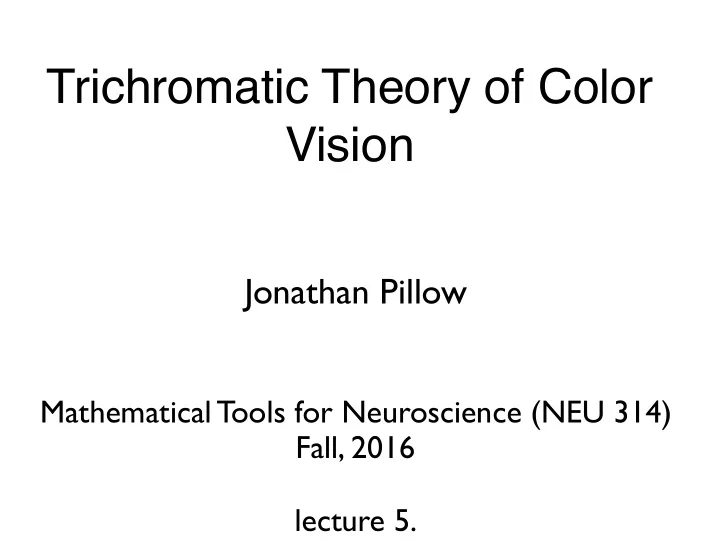

Trichromatic Theory of Color Vision Jonathan Pillow Mathematical Tools for Neuroscience (NEU 314) Fall, 2016 lecture 5.
Linear algebra “Linear algebra has become as basic and as applicable as calculus, and fortunately it is easier.” - Glibert Strang, Linear algebra and its applications
Motivation: James Maxwell’s color-matching experiment Given any “test” light, you can match it by adjusting the intensities of any three other lights (2 is not enough; 4 is more than enough & produces non-unique matches)
A little physics background: light • Really: just a particular range of the electromagnetic spectrum • (We see only the part between 400 and 700 nm)
Q : How many numbers would you need to write down to specify the color of a light source? Just one? (“the wavelength”?) eg. “650”?
Q : How many numbers would you need to write down to specify the color of a light source? spectral properties A : It depends on how you “bin” up the spectrum • One number for each spectral “bin”: 20 17 16 15 13 12 example: 13 10 energy bins 5 0 0 0 0 0 (a vector!)
Device: hyper-spectral camera • measures amount of energy in each range of wavelengths • can use thousands of bins (or “frequency bands”), instead of just the 13 shown here 20 17 16 15 13 12 10 energy 5 0 0 0 0 0
Some terminology for “colored” light: spectral - referring to the wavelength of light the illuminant - light source amount of energy (or illuminant power spectrum - this curve. power) at each frequency 20 17 16 15 13 12 10 energy 5 0 0 0 0 0
an illuminant with most power at long wavelengths (i.e., a reddish light source ) energy
an illuminant with most power at medium wavelengths (i.e., a greenish light source ) energy
an illuminant with power at all visible wavelengths (a neutral light source, or “white light”) energy
Q: How many measurements of the illuminant spectrum does the human eye take (in bright conditions?) A: Only 3! photoreceptor response One measurement for each cone class What mathematical could also call operation do we this axis mean by “measure”? “ absorption ” or “ sensitivity ”
More terminology: absorption spectra - describe response (or “light absorption”) of a photoreceptor as a function of frequency photoreceptor response Absorption spectrum for “L” (red) cone The cone absorption spectra are basis vectors for a three- dimensional vector space (a subspace ) within the space of all spectra.
Written in a linear algebra setting S = M L cone cone absorption responses spectra illuminant spectrum
So: single cone can’t tell you anything about the color of light! (“It’s just giving you dot products, man!”) Colored stimulus Response of your “S” cones
Color vision Our color vision relies on comparing the responses of three cone classes photoreceptor response
Two lights x 1 and x 2 “match” iff (i.e., they evoke the same cone responses) So in linear algebra terms: metamers refer to an entire (affine) subspace of lights that have the same linear projection onto the 3 cone absorption spectra basis vectors.
40 175 240 cone responses: (dot products) 1 percept 0.8 sensitivity 0.6 0.4 0.2 0 400 450 500 550 600 650 700 illuminant #1 Metamers energy #4 - Illuminants that are #3 physically distinct but #2 perceptually indistinguishable wavelength
James Maxwell (1831–1879): color-matching experiment • Any “test” light (“vector”), can be matched by adjusting the intensities of any three other lights (“basis vectors”) • 2 is not enough; 4 is more than enough
Implication: tons of things in the natural world have different spectral properties, but look the same to us. But, great news for the makers of TVs and Monitors: any three lights can be combined to approximate any color. Single-frequency spectra produced by (hypothetical) monitor phosphors illuminant #1 Monitor phosphors energy produce “metameric match” to illuminant #1 (or any other possible illuminant). wavelength
Close-up of computer monitor, showing three phosphors, (which can approximate any light color)
Written as a linear algebra problem p3 p2 p1 = input to each phosphor spectra of spectrum monitor phosphors produced
This wouldn’t be the case if we had more cone classes. hyperspectral marvel: mantis shrimp (stomatopod) • 12 different cone classes • sensitivity extending into UV range • 12-dimensional color vision space
Real vs. Conterfeit $$ Output of hyper-spectral camera (colorized artificially)
• Large variability across individuals! • But, doesn’t have (strong) effects on color space
color blindness • About 8% of male population, 0.5% of female population has some form of color vision deficiency: Color blindness • Mostly due to missing M or L cones (sex-linked; both cones coded on the X chromosome)
Types of color-blindness: dichromat - only 2 channels of color available (i.e., color vision defined by a 2D subspace) (contrast with “trichromat” = 3 color channels). Three types, depending on missing cone: Frequency: M / F • Protanopia : absence of L-cones 2% / 0.02% • Deuteranopia : absence of M-cones 6% / 0.4% • Tritanopia : absence of S-cones 0.01% / 0.01% includes true dichromats and color-anomalous trichromats
So don’t call it color blindness . Say: “Hey man, I’m just living in a 2D subspace.”
Other types of color-blindness: • Monochromat: true “color-blindness”; world is black-and-white • cone monochromat - only have one cone type (vision is truly b/w) • rod monochromat - visual in b/w AND severely visually impaired in bright light
Rod monochromacy
Color Vision in Animals • most mammals (dogs, cats, horses): dichromats • old world primates (including us): trichromats • marine mammals: monochromats • bees: trichromats (but lack “L” cone; ultraviolet instead) • some birds, reptiles & amphibians: tetrachromats!
Recommend
More recommend